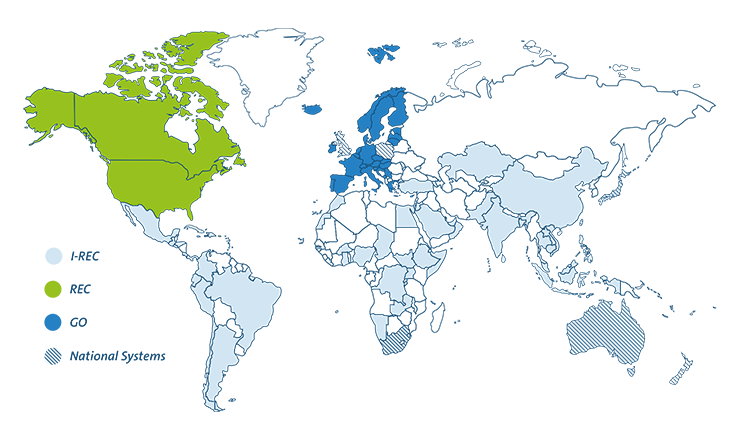First Climate’s Green Energy Specialist Lotus Shaheen reflects on important trends and developments for International Renewable Energy Certificates (I-RECs) and developments for 2023.

In 2022 we saw yet another year of growth for the I-REC markets. Since the establishment of the standard, the global market for I-RECs has been growing rapidly, reaching 46 markets worldwide. Approximately 85 million total certificates were redeemed in 2021—more than half that in 2020.
This year, I-RECs are expected to grow even further, and exciting new I-REC developments are expected, as highlighted at the first ever specialized I-REC Standard Conference (ISC) in Bangkok, Thailand. So, what can companies expect from I-RECs in 2023?
Trend 1: More I-REC availability in Asia and Latin America
One of the most prominent trends in the I-REC markets is the fast growth of the Asian and Latin American regions. China spearheaded the volume of certificates issued worldwide, reaching a peak of approx. 67 million MWh in 2021. Meanwhile, Brazil dominates almost 50% of the total volume of certificates issued in Latin America and the Caribbean region. The country reached approx. 21 million MWh in the same year. The fast-developing BRIC economy was followed by Chile and Mexico with respect to the total volume of I-REC certificates issued.
In 2022, the trend seems to survive with China, Brazil and Turkey as top three I-REC issuers.
What this shows for 2023 is that renewable energy projects are increasingly accessing the I-REC market, and more I-REC volume is available for corporations to procure in Asia and Latin America. Market growth is being recognized by market players in these regions, especially from the supply side.

Trend 2: More Companies Reducing Supply Chain and Scope 3 Emissions with I-RECs
Up until now, I-RECs have primarily been a tool for reducing a company’s scope 2 emissions. But as companies look closer at their supply chains, we may see more companies choosing to source renewable energy across their supply chain to also reduce scope 3 emissions. With this we could see an increased importance on more accurate and transparent reporting. This could mean the introduction of new tracking tools for certficates intended for reducing emissions from downstream energy consumption.
Trend 3: Hydrogen could be launched on the market with I-REC(H)
Although green hydrogen is still in its early stages as a commercial market, it is already a hot topic of discussion in many public and private circles worldwide. I-REC(H), a standard under ongoing development for hydrogen, showcased how the fundamental constituent of the I-REC(E) product,(the global attribute tracking system for electricity under the I-REC Standard), could serve as a valuable basis for launching a global attribute tracking standard for green hydrogen.
Trend 4: Finer granularity of I-REC Products
As the market expands rapidly, more sophisticated tracking concepts could evolve, such as the introduction of a finer time interval granularity (for example, 15- or 60-minute interval products). This could be one way to ensure that the purchased renewable energy certificates originate from generation that feed the grid at the exact time of consumption. Such a product can be helpful for specific industries or case-studies, such as for the tracking of green hydrogen.
On the other hand, technical and commercial challenges are still on the horizon of finer granularity, such as physical power dispatch rules, national regulations on grid data, or an expected price premium on these certificates.
Trend 5: Possible global standardization
Global standardization is considered one of many important means of documenting, as well as tracking, renewable energy claims in an accountable and transparent way. This was a critical discussion during the I-REC conference and while unlikely to happen already in 2023, companies can expect talks of global standardization of I-RECs to continue throughout the year.

Trend 6: Streamlined I-REC trading with ASEAN
A primary discussion during the conference sessions was ASEAN market integration to support cross-country transactions of Energy Attribute Certificates (EACs) in countries with harmonized physical power markets. This could be a regional market transformation pathway which may allow corporates with renewable energy targets to source their EAC needs more efficiently.
Similar to the standardization of global attribute markets, ASEAN market integration is unlikely to happen in 2023, but companies can expect developments to continue throughout the year regarding the I-REC market and relevant products to the I-REC Standard or other similar organizations. These harmonized products would mean that they would likely be more transparent and may streamline market activity. Hence, trading these renewable energy certificates becomes simpler and quicker.
Trend 7: Expect more emerging markets
At the country level, 2022 witnessed nine new markets approved for I-REC issuance, including Kazakhstan, Zambia, Cambodia, Lebanon, Ecuador, Pakistan, Brunei, Haiti, and Ethiopia. Japan and Pakistan have topped up the market progress with first instruments registered in these two markets. We still have yet to see how these nascent markets will develop, but it is highly likely that we will see more countries join their ranks in 2023 as I-RECs become more well-known and lucrative.

In a nutshell
I-RECs are an important part of the EAC market, offering international consumers a way to add renewable energy procurement into their climate strategy. The standard has witnessed major growth in the past few years, and the number of market participants is rapidly increasing. New market innovations are likely to enter the I-REC scene soon and 2023 will likely see further expansion, meaning companies will have more opportunities than ever before to include renewable energy procurement in their climate strategies.
If you are a corporation with ambition to source renewable energy from different international markets, I-RECs can be a useful market instrument to reach your goal. Reach out to our Sales and Renewable Energy Team at First Climate to assess your needs and consult on the right green energy solution for you!
Good to know:
What are I-RECs?
Why are I-RECs important?



